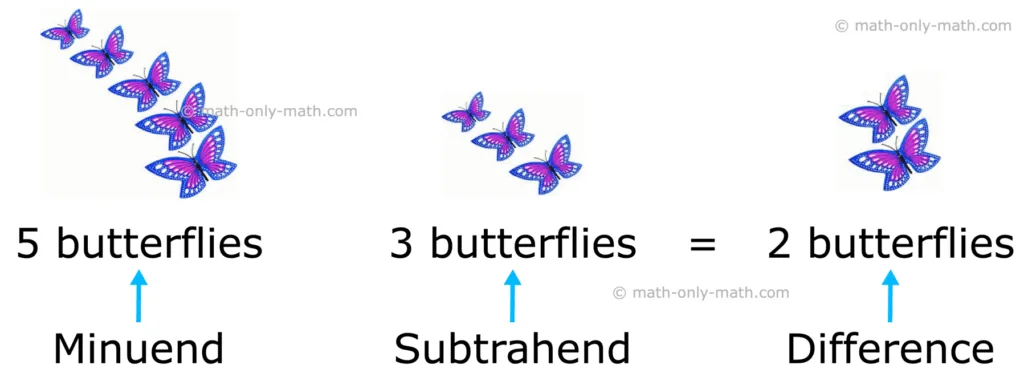Subtraction means taking away some objects or numbers from a group of objects or numbers. It is used to find the remaining numbers. It is also used for comparing two numbers or groups.
The bigger number from which we subtract a smaller number is called the minuend. The small number that is subtracted from the bigger number is called the subtrahend. Here, 5 is minue and 3 is subtrahend. The answer in subtraction is called the difference. Here, 2 is difference.
When we subtract a smaller number, except: 0, from a bigger number, the difference is alway smaller than the minuend.
We will learn subtraction of two-digit numbers, 3-digit numbers, 4-digit numbers, 5-digit numbers, etc. with and without regrouping. We know that to subtract numbers, we first arrange them in place value columns and then subtract the digits under ones, tens and hundreds columns.
While performing subtraction, the smaller number is always subtracted from the larger number. The smaller number is called minuend and the larger number is called subtrahend. The result is called the difference.
Now, solve the following questions given below to refresh the concepts we have learnt already.
The answer of a subtraction sum is called DIFFERENCE.
How to subtract 2-digit numbers?
Steps are shown to subtract 2-digit numbers.
Subtract 39 from 78.
Line up the numbers according to place value taking care to place the bigger number on top.
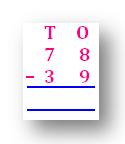
In the ONES column we have 8 – 9.
We cannot take away 9 from 8 so we REGROUP the next place to the left. REGROUP 78 as 6 TENS and 18 ONES.
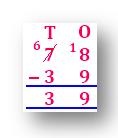
DIFFERENCE = 39
Sometimes we need to REGROUP more than once.
How to subtract 3-digit numbers?
Steps are shown to subtract 3-digit numbers.
Subtract 189 from 638.
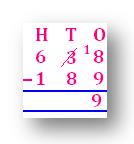
REGROUP 38 as 2 TENS 18 ONES
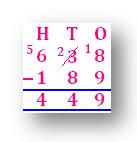
REGROUP 62 as 5 TENS 12 ONES
Answer: 449
We follow the same rule for subtracting 4 digits numbers or larger numbers.
Subtraction of 4-Digit Numbers without Regrouping Video
Subscribe to our YouTube channel for the latest videos, updates, and tips.
How to subtract 4-digit numbers?
Steps are shown to subtract 4-digit numbers.
1. Solve: 74834 – 38915
Line up the number according to place value.
In the ONES column the number to be subtracted is greater so REGROUP as 2 TENS 14 ONES.
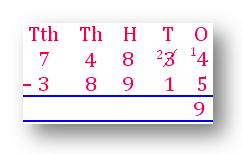
Subtract the TENS column.
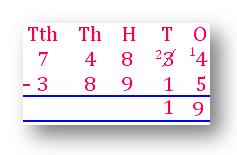
REGROUP to subtract the numbers in the HUNDREDS column.
3 THOUSANDS 18 HUNDREDS
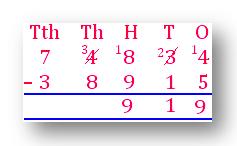
REGROUP to subtract the numbers in the THOUSANDS column.
6 TEN THOUSANDS 13 THOUSANDS
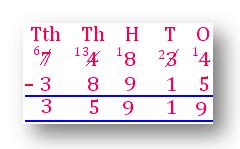
Answer: 35919
We can subtract from a place with a zero. Just remember to REGROUP the next place to the left.
2. Subtract: 39507 – 27386
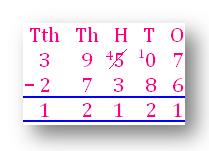
Answer: 12121
REGROUP to subtract the TENS place
4 HUNDREDS 10 TENS
How to check the answer of a subtraction?
Subtract 2157 from 5438 and check your answer.
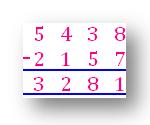
CHECK:
Add the DIFFERENCE to the smaller number.
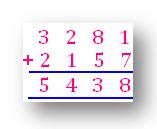
The answer will be the smaller number.
Subtract the DIFFERENCE from the greater number.
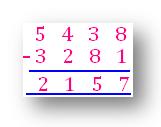
The answer will be the greater number.
In subtraction we will learn the subtraction operation of numbers having
more than 4 digits with borrowing and without borrowing.
Examples:
1. Subtract 2684 from 6795.
Solution:
The numbers are arranged in column form

(i) Ones are subtracted, 5 – 4 = 1
(ii) Tens are subtracted, 9 – 8 = 1
(iii) Hundreds are subtracted, 7 – 6 = 1
(iv) Thousands are subtracted, 6 – 2 = 4
Hence, difference = 4,111
2. Subtract 6732 from 9340 (with borrowing).
Solution:
The numbers are arranged in column form

(i) Ones are subtracted, 0
Now 1 Ten or 10 + 0 = 10, 10 – 2 = 8
(ii) Tens are subtracted, 3Tens – 3Tens = 0
(iii)Hundreds are subtracted, 3 Hundreds
so 10 Hundreds + 3 Hundreds = 13 Hundreds,
13 Hundreds – 7 Hundreds = 6 Hundreds.
(iv) Thousands are subtracted, 8Thousands – 6Thousands = 2Thousands
Hence, difference = 2,608
Subtraction of 4-Digit Numbers with Regrouping Video
Subscribe to our YouTube channel for the latest videos, updates, and tips.
3. What is the difference between 40712 and 7549? (with borrowing)
Solution:
The numbers are arranged in column form
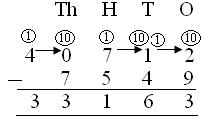
(i) 2
(ii) 0
(iii) 6H – 5H = 1H
(iv) 1 Tth is borrowed, 10Th – 7Th = 3Th
(v) 3Tth – 0 = 3Tth
So, difference = 33,163
4. Subtract 2 3 7 4 1 2 from 6 4 9 5 2 3 (without borrowing)
Solution:
Numbers are arranged in column form
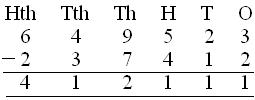
(i) 3 – 2 = 1 Ones
(ii) 2 – 1 = 1 Tens
(iii) 5 – 4 = 1 Hundreds
(iv) 9 – 7 = 2 Thousands
(v) 4 – 3 = 1 Ten thousands
(vi) 6 – 2 = 4 Hundred thousands
Therefore, difference = 412111
5. Subtract (with borrowing) 6 5 6 2 9 from 3 2 3 4 7 8
Solution:
Numbers are arranged in column form
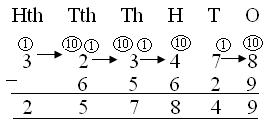
(i) Ones: 8
(ii) Tens: 6T – 2T = 4T
(iii) Hundreds: 4H
(iv) 2Th
(v) 1Tth
(vi) 2Hth remained as it was.
So, difference = 257849
6. Find the difference between two numbers, 1 4 2 7 1 3 and 3 7 4 3 9.
Solution:
The numbers are arranged in column form.
142713 is greater than 37439, so 37439 will be subtracted from 142713.
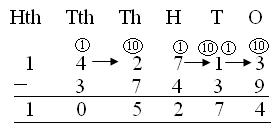
Difference = 105274
(i) Ones are subtracted
3
Now 1T or 10 + 3 = 13, 13 – 9 = 4
(ii) Tens are subtracted, 1T
Now 1H or 10T + 1 = 11,
11 – 3 = 8, answer is 11 – (3 + 1) = 7
(iii) Hundred: 6H – 4H = 2H
(iv) Thousands: 12Th – 7Th = 5Th
(v) Ten thousands: 3Th – 3Th: = 0
(vi) Hundred thousand: 1Hth – 0 = 1Hth
Therefore, 142713 – 37439 = 105274
3. Find the difference.
For examples:
(i) 4 ten thousands – 24 thousands
4 ten thousands → 40 thousands
– 24 thousands → – 24 thousands
16 thousands
(ii) 6 thousands 3 hundreds – 4 thousands 17 hundreds
6 thousands 3 hundreds → 5 thousands + 13 hundreds
– 4 thousands 17 hundreds → – 5 thousands + 7 hundreds
6 hundreds
(iii) 43 lakhs – 17 lakhs 23 hundreds
43 lakhs → 42 lakhs + 100 hundreds
– 17 lakhs 23 hundreds → – 17 lakhs + 23 hundreds
25 lakhs + 77 hundreds
or, 25 lakhs 77 hundreds
Note: Subtraction is done only in the same grouping.
Worksheet on Subtraction:
I. Match the numbers in the two columns:
|
Column A (i) 400 – 200 (ii) 685 – 10 (iii) 570 – 5 (iv) The predecessor of 782 (v) 853 – 0 |
Column B (a) 781 (b) 853 (c) 200 (d) 565 (e) 675 |
Answer:
(i) → (c)
(ii) → (e)
(iii) → (d)
(iv) → (a)
(v) → (b)
II. Write any two numbers that come before the given
numbers:
(i) ……………, ……………, 654
(ii) ……………, ……………, 316
(iii) ……………, ……………, 781
(iv) ……………, ……………, 999
(v) ……………, ……………, 100
(vi) ……………, ……………, 588
Answer:
(i) 652, 653
(ii) 314, 315
(iii) 779, 780
(iv) 997, 998
(v) 98, 99
(vi) 586, 587
III. Fill in the blanks:
(i) 346 – 100 = ……………
(ii) 412 – 10 = ……………
(iii) 587 – 27 = ……………
(iv) 697 – 590 = ……………
(v) 962 – 15 = ……………
(vi) 740 – 80 = ……………
Answer:
(i) 246
(ii) 402
(iii) 560
(iv) 107
(v) 947
(vi) 660
IV. Subtract the given numbers:
(i) 459 – 234
(ii) 762 – 430
(iii) 905 – 665
(iv) 652 – 483
(v) 790 – 548
(vi) 809 – 719
Answer:
(i) 225
(ii) 332
(iii) 240
(iv) 169
(v) 242
(vi) 90
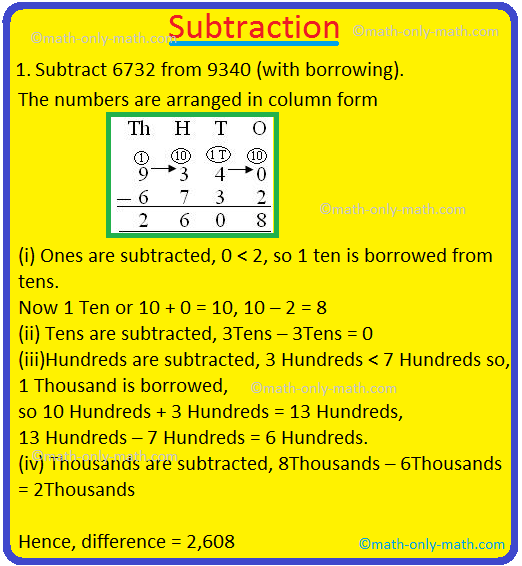
V. Subtract:
|
(i) 5 7 8 – 1 0 4 ____________ |
(ii) 5 9 1 – 2 3 0 ____________ |
|
(iii) 5 8 9 – 1 3 6 ____________ |
(iv) 4 0 0 – 3 2 2 ____________ |
|
(v) 2 5 3 – 1 0 6 ____________ |
(vi) 9 0 0 – 3 7 5 ____________ |
Answer:
V. (i) 474
(ii) 361
(iii) 453
(iv) 78
(v) 147
(vi) 525
VI. Find the difference between:
(i) 725 and 400
(ii) 153 and 965
(iii) 781 and 243
Answer:
VI. (i) 325
(ii) 812
(iii) 538
VII. Arrange the following numbers in columns and subtract:
(i) 431 from 846
(ii) 261 from 642
(iii) 524 from 800
Answer:
VII. (i) 415
(ii) 381
(iii) 276
VIII. Word Problem on Subtraction:
(i) What must be added to 243 to get 605?
(ii) The sum of two numbers is 924. If the greater of the two numbers is 624, find the smaller number.
(iii) Shelly has a basket full of fruits to sell. She has 326 fruits with her. She sells 180 in the morning and 75 in the evening. How many fruits are still left with her to be sold?
(iv) Neil fill 437 litres of water in the tank. His family uses 359 litres of water in a day. How much water is still left in the tank?
Answers:
(i) 362
(ii) 300
(iii) 71
(iv) 78 litres
Related Concept
● Addition
● Word
Problems on Addition
● Subtraction
● Check
for Subtraction and Addition
● Word
Problems Involving Addition and Subtraction
● Estimating
Sums and Differences
● Find the
Missing Digits
● Multiplication
● Multiply
a Number by a 2-Digit Number
● Multiplication
of a Number by a 3-Digit Number
● Multiply a Number
● Estimating Products
● Word
Problems on Multiplication
● Multiplication
and Division
● Terms Used in
Division
● Division
of Two-Digit by a One-Digit Numbers
● Division
of Four-Digit by a One-Digit Numbers
● Division
by 10 and 100 and 1000
● Dividing Numbers
● Estimating
the Quotient
● Division
by Two-Digit Numbers
● Word
Problems on Division
4th Grade Math Activities
From Subtraction to HOME PAGE
Didn’t find what you were looking for? Or want to know more information
about Math Only Math.
Use this Google Search to find what you need.

